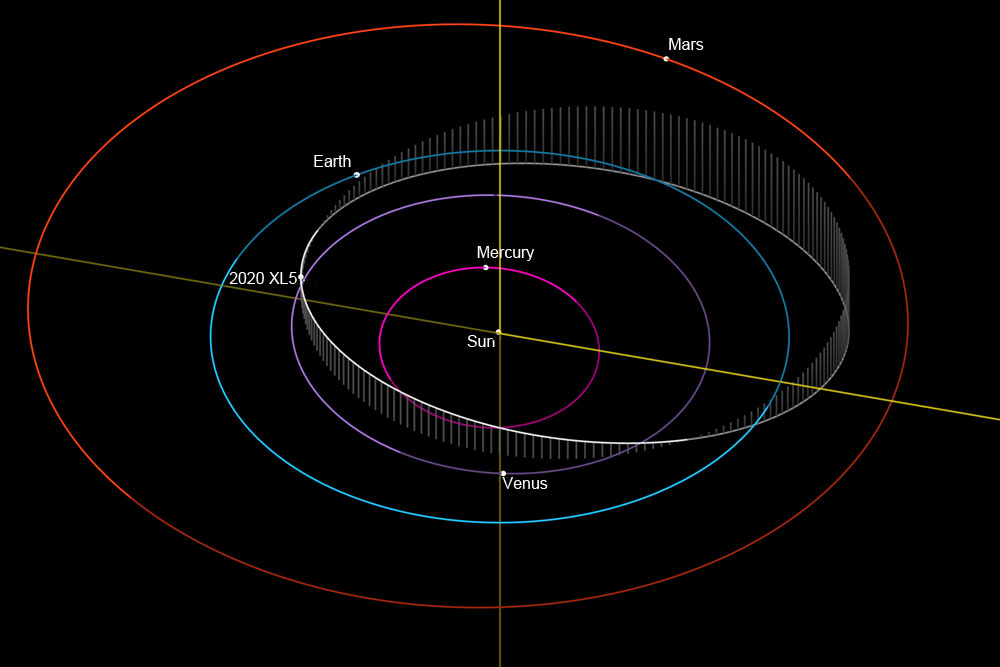Astronomers have finally confirmed the status of asteroid 2020 XL5, discovered in 2020, as the second near-Earth Trojan. It was captured by the Earth 600 years ago and will be with our planet for another 4,000 years. It is more than one kilometer in diameter – it is larger than the first Trojan asteroid, whose diameter is three hundred meters.
Trojan asteroids are a natural population of the vicinity of the Lagrange points L4 and L5 of the Sun-planet systems, where the balance of gravitational and centrifugal forces is stable. They are in 1:1 mean motion resonance with the planet. Currently, more than 7 thousand Trojans belonging to Jupiter have been found, Neptune has 28 of them, Mars has 9, and Uranus and Venus have only one each.
Until recently, only one Trojan asteroid 2010 TK 7, discovered in 2011, was known near the Earth. It has been dynamically stable for only a quarter of a million years, and therefore, most likely, it could have previously been captured from somewhere as a near-Earth asteroid.
Asteroid 2020 XL5 was discovered by Pan-STARRS (Panoramic Survey Telescope and Rapid Response System) on December 12, 2020. Further observations of it in 2021 allowed astronomers to assume that they were facing the second known terrestrial Trojan, but there was not enough data for a final decision.

The orbit of near-Earth Trojan asteroid 2020 XL5, which could become an important target for future research. Credit: JPL Small-Body Database Browser
A team of astronomers led by Toni Santana-Ros of the University of Barcelona in Spain has announced that they have confirmed the status of 2020 XL5 as the second terrestrial Trojan asteroid. The scientists used observational data from various ground-based telescopes between 2012 and 2019 and 2021 to refine the orbit, determine properties, and investigate the object’s stability at the L4 point of the Sun-Earth system.
NEWSLETTER
Never miss a news release from the Curiosmos team.
Scientists have come to the conclusion that 2020 XL 5 has not been with the Earth since its formation, but was captured about 600 years ago and will be an Earth Trojan for another 4 thousand years, after which it will leave the Earth.

The orbit of 2020 XL5 (green) relative to the orbits of Mercury and Venus (white), Earth (blue), and Mars (orange). Credit: Tony Dunn
An analysis of the photometric data showed that the asteroid could be of the C type and be a dark body containing a lot of carbon. Its diameter is estimated at 1.18 kilometers, the absolute magnitude is 18.58, and the albedo is 0.06.
The researchers also determined that both terrestrial Trojans are difficult targets for robotic research vehicles that launch from low-Earth or geostationary transfer orbits. However, in the case of 2020 XL5, the possibility of research from a flyby trajectory remains.
Of course, the asteroids might not be ideal at this point in time but in a few years, we might have the technologies for a proper landing. Moreover, even if this type of mission remains out of the question, near-Earth Trojan asteroids could be used to install scientific instruments for research.
Join the discussion and participate in awesome giveaways in our mobile Telegram group. Join Curiosmos on Telegram Today. t.me/Curiosmos
Sources:
• Carter, J. (2022, February 3). Found: The new biggest ‘earth trojan’ asteroid that could be a future target for NASA or Space Miners Say Scientists. Forbes.• Gohd, C. (2022, February 1). Earth has an extra companion, a trojan asteroid that will hang around for 4,000 years. Space.com.
• Pappas, S. (2022, February 2). 2nd ‘trojan asteroid’ confirmed orbiting with Earth. LiveScience.
• Rabie, P. (2022, February 1). Scientists discover an asteroid trapped near Earth for the next 4,000 years. Inverse.
• Santana-Ros, T., Micheli, M., Faggioli, L., Cennamo, R., Devogèle, M., Alvarez-Candal, A., Oszkiewicz, D., Ramírez, O., Liu, P.-Y., Benavidez, P. G., Campo Bagatin, A., Christensen, E. J., Wainscoat, R. J., Weryk, R., Fraga, L., Briceño, C., & Conversi, L. (2022, February 1). Orbital Stability Analysis and photometric characterization of the second earth trojan asteroid 2020 XL5. Nature News.